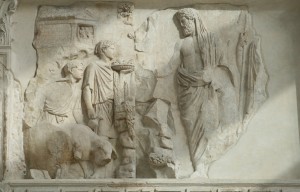The research project focused on politically loaded concepts of space, especially in archaic and Hellenistic Greece and Augustan Rome, resp. The leading concepts were genealogical notions of space and “dynastic” concepts.
Research
Genealogies are fictions that help their audiences to navigate not only time but also space (see, e,g, the genealogical passages in the OT or Hesiod). Authors who construct such genealogies, project the political geography of their present world into the past and thus translate them into genealogical relations. Authored long before the maps or even before the hodological texts we have were fashioned, such genealogical texts thus provide insights into how space was experienced and presented. Ancient Greek cultures know this function of genealogy just as well as neighboring Semitic ones, among which ancient Israel is especially well-researched. In Hellenistic court-culture and its ways of representing dynastic power a new way of how to experience space and represent it in art emerges, namely a dynastic concept of oikoumene. Dynastic space unfolds from a center and constantly refers the reader or viewer back to it. Roman rule and ruling-class artists then partly adopt such forms of imagining space, often by intentionally referring back to Greek models, partly they integrate specific Roman facts and concepts, (such as the competition of Italian cities and regions with Rome, the competition of Roman gentry among themselves, the emerging supremacy of the Julian family) and construct their own genealogical narratives. In late Hellenistic time, antiquarian research and a new regime combine their efforts to create an imagined mytho-geographical notion of a unified Italy.
While this project has folded, Markus Asper’s interests in genealogical and dynastic space have become part of his research project (C-4-4) Imaginary space: Backround or protagonist?.

